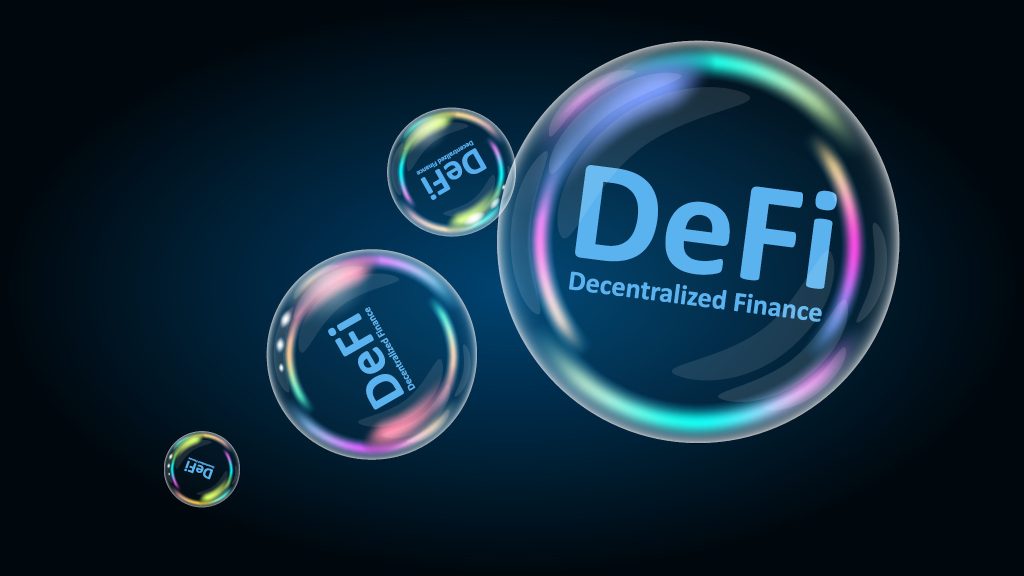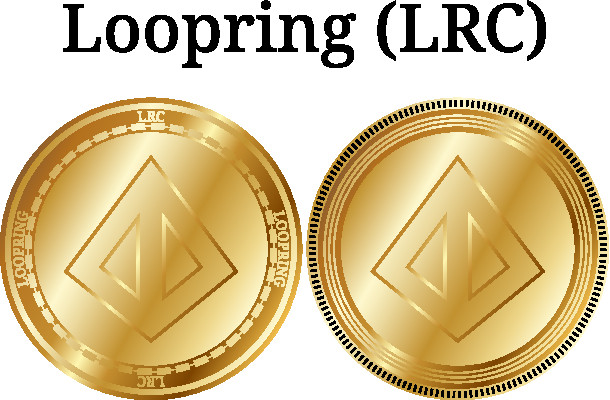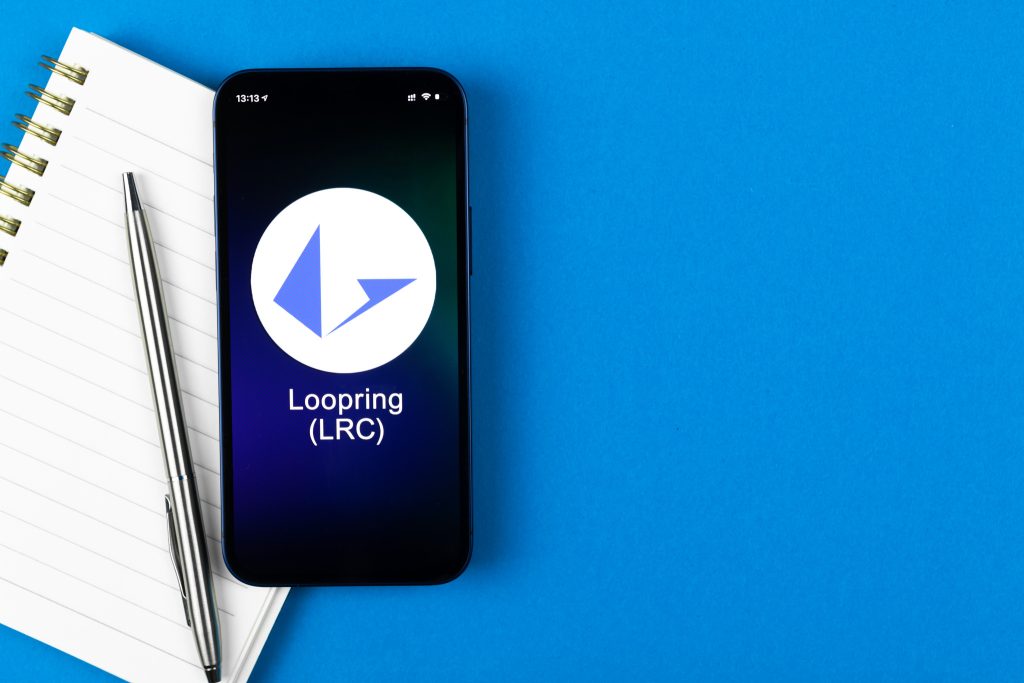What Is Loopring (LRC)?
Founded by ex-Google software engineer Daniel Wang, Loopring seeks to make trading assets and making payments on Ethereum faster and cheaper, without sacrificing the fundamental security that Ethereum provides.
As the number of decentralized finance (DeFi) projects on Ethereum has increased, so too have the transaction fees and times associated with trading on it.
In February 2021, the average ETH transaction fee hit an all time high of nearly $40. This is exactly what Loopring aims to remedy, by delivering a digital economy that empowers its users while still giving them complete control over their assets.
With Loopring, people no longer have to sacrifice efficiency and affordability to take advantage of Ethereum’s network security.
Interested in Loopring (LRC), but not sure what it’s all about or where to even begin? Don’t worry – this handy guide is designed to teach you everything you need to know about the project and get you ready to jump into the most user-friendly trading experience available on the market.
The introduction of the decentralized exchange (DEX) has given users the ability to trade without the need of a custodian or intermediary. Liquidity can be an issue if DEXs don’t interoperate and share orders across a wide network. Additionally, as trades are executed on chain, DEXs are limited by the scalability and efficiency of the underlying blockchain.
Loopring (LRC) is an Ethereum Layer-2 scaling protocol that enables the building of decentralized exchanges which rival centralized exchanges in terms of performance. As of Loopring v3.0, the network can handle up to 2025 transactions per secdion approximately 1,000 times more trades per second than Ethereum with each one costing a mere fraction of a cent.
Loopring also inherits the security of Ethereum’s blockchain, with users having access to their assets in all circumstances and exchange operators being constrained to behaviour allowed by the protocol.
How Does Loopring Work?
zkRollups
Loopring (LRC) achieves better performance than traditional decentralized exchanges by creating a “fast lane” where transactions are aggregated and executed off-chain to avoid Ethereum’s network congestion. This is done through the use of a Layer-2 scaling solution called zkRollups, which bundle lots of transactions together off-chain before submitting them to the Ethereum blockchain as a single transaction.
By this method, the number of transactions Loopring submits to the Ethereum network to be settled is greatly reduced, making trades on Loopring much faster and cheaper. This approach is incredibly efficient and places far less strain on the Ethereum network as well.
The “zk” in zkRollup stands for “zero knowledge” and refers to the type of proof that Loopring must provide to verify that the off-chain transactions are accurate. A good way to think about ‘zero knowledge’ proof is that it’s kind of like showing someone the answer to a calculation, without revealing the equations that were used to reach it.
Order rings
On other exchanges, an order to buy a particular token in a trading pair must be matched with another order to sell that token within the same trading pair. Loopring, however, mixes and matches multiple orders in a circular trading system known as an order ring. Each order ring contains up to 16 orders and creates a loop where each order can exchange the desired tokens without an opposing order for its pair being necessary.

Who Are The Founders of Loopring? (History of Loopring)
As mentioned in the introdduction, Loopring was founded in 2017 by software engineer Daniel Wang. After gaining a Masters degree in Computer Science from Arizona State University, Daniel Wang was Lead Software Engineer at medical manufacturing company Boston Scientific before working at Google as Tech Lead and Senior Software Engineer. Wang is the company CEO and manages protocol development alongside Jay Zhou (CMO) and Johnston Chen (COO).
The initial coin offering (ICO) for Loopring took place in August 2017 and raised $45 million. However, most of the funds raised were returned to ICO participants due to China’s tightening regulations. The rest was used for development of the protocol by the Loopring Foundation, a non-profit operating out of Shanghai.
In December 2019, the protocol transitioned from Loopring 2.0 to Loopring 3.0, leading to an almost 1000x improvement in efficiency. It also partnered with Bitcoin to integrate oracles in the same month.
After struggling to find third parties to build DEXs on the protocol, Loopring released their own decentralized exchange in February 2020. The non-custodial Loopring Exchange is based on both orderbook and automated market maker (AMM) trading and also functions as a payment app.
What Makes Loopring Unique?
Loopring combines the benefits of both centralized and decentralized cryptocurrency exchanges. Its innovative use of zkRollups allows it to achieve higher throughput and lower costs than any other decentralized exchange built on the Ethereum blockchain, while its non-custodial technology presents an improvement to the security of centralized exchanges.
The high level performance capabilities that Loopring offers mean that algorithmic traders are able to use high-frequency trading strategies on DEXs for the first time. Loopring also employs a cryptographic solution which prevents frontrunning (when someone gets their own trades executed before pending transactions in order to profit from the price change that will result from said transactions).
The protocol is open-source and audited, and doesn’t rely on any external validators, meaning no person, company, or government can come between a user and their cryptocurrencies. Furthermore, users automatically receive a digital receipt for all deposits and withdrawals, meaning funds can always be recovered – even if the decentralized exchange encounters issues.
What Gives Loopring Value?
The Loopring (LRC) cryptocurrency is the utility token of the Loopring network. It incentivizes positive behavior from liquidity providers, insurers, and DAO (decentralized autonomous organization) governors — as well as giving them a say in how the protocol is run.
An operator must lock up at least 250,000 LRC in order to run a decentralized exchange on Loopring that uses the protocol’s on-chain data availability. To operate a DEX without this feature requires 1 million LRC to be staked.
LRC is deflationary as tokens from some of the fees and from operators who have their stake slashed for bad behaviour get burned. This means the total LRC supply decreases over time which can impact Loopring’s token price and market cap.
Loopring partnered with gaming giant Gamestop to support their NFT marketplace. Launched in Beta on Monday 11th July, the marketplace processed more transactions in just over 48 hours than the total of Coinbase’s same marketplace offering. Loopring’s Layer 2 also is the protocol behind the Gamestop Wallet.
How Many Loopring (LRC) Coins Are There In Circulation?
Loopring (LRC) currently has a circulating supply of 1,245,991,469 and a max supply of 1,374,513,896 LRC. Over 20 million LRC have been burned since the launch of the Loopring protocol and any LRC that has been locked up for operating exchanges is currently off the market.
10% of all fees go to the Loopring DAO, which votes on how to spend those funds. Options include grants, impermanent loss protection, further liquidity incentives, and buying back LRC to burn. Any LRC the DAO votes to burn, along with any that is confiscated from exchange operators not acting in good faith, decreases the circulating supply of LRC.
Technical Data
The Loopring protocol can settle up to 2,025 trades per second with each trade costing roughly 450 to 800 GAS on the Layer-1 blockchain. These statistics are bound to increase in efficiency regularly as the Loopring Foundation continues to develop the core Loopring Protocol.
The current iteration of Loopring is known as Loopring 3.0.

How To Use Loopring
In addition to locking up LRC to operate an exchange, those with less LRC can also participate in the network. 80% of the protocol fees go to liquidity providers in AMM pools and makers on orderbook pairs, with at least half of this amount going to LRC-related trading pools and trading pairs.
To protect against the risk of unforeseen bugs, the Loopring insurance fund was created. Anyone can deposit LRC into this fund and earn a proportional share of 10% of fees.
With the launch of the Loopring DAO, users will be able to stake their LRC through the token voting tool Snapshot to govern parameters such as the fee percentage, fee distribution proportions and insurance fund covered event triggers.
How To Choose a Loopring Wallet
Loopring launched a beta version of their own mobile smart contract wallet for Android, with an iOS version expected soon. It’s self-custodial and provides the ability to swap on the AMM.
There are also plenty of other places you could store your Loopring and the wallet you choose will likely depend on what you want to use it for and how much you need to store.
Hardware wallets or cold wallets like Ledger or Trezor provide the most secure option for storing cryptocurrencies with offline storage and backup. However, they can involve a bigger learning curve and are a more expensive option. As such, they may be better suited to storing larger amounts of LRC for more experienced users.
Software wallets provide another option and are free and easy to use. They are available to download as smartphone or desktop apps and can be custodial or non-custodial. With custodial wallets, the private keys are managed and backed up on your behalf by the service provider. Non-custodial wallets make use of secure elements on your device to store the private keys. While convenient, they are seen as less secure than hardware wallets and may be better suited to smaller amounts of LRC or more novice users.
Online wallets or web wallets are also free and easy to use, and accessible from multiple devices using a web browser. They are, however, considered hot wallets and can be less secure than hardware or software alternatives. As you are likely trusting the platform to manage your LRC, you should select a reputable service with a track record in security and custody. As such, they are most suited for holding smaller amounts of cryptocurrencies or for those making more frequent trades.
Buying and selling LRC, or trading it for any other cryptocurrency, is done in mere moments when you choose our secure platform as your storage solution.
Loopring Staking
Operating a DEX requires a stake of at least 250,000 LRC, which can be penalized for submitting transaction histories to the Ethereum blockchain that are faulty or late, or not executing user withdrawals quickly enough. The entire stake can be lost if any outstanding user funds are not returned before the DEX is shut down.
DEX operators, or anyone else who wants to, can also stake Loopring to lower fees on that decentralized exchange. 2.5 million LRC is required to lower the taker fee from 0.05% to 0.025% and an additional 1 million LRC is needed to lower the maker fee from 0.025% to 0%.
Loopring 3.0 allowed users to stake any amount of LRC to earn a proportion of 70% of all protocol fees. This came to an end at the start of 2021, with the fees now going instead to liquidity providers (80%), insurance fund depositors (10%) and the DAO (10%).
Choosing Loopring
Loopring enables the independent operation of decentralized, autonomous cryptocurrency exchanges that provide the performance of centralized exchanges with the added benefits of decentralization. It achieves improvements to efficiency and liquidity through innovative cryptographic techniques such as the zkRollup and the order ring mechanism.
Throughput on Loopring is 1,000 faster than on Ethereum for 1/100th of the cost, providing the opportunity for certain high-speed trading strategies to be deployed on DEXs for the first time. Loopring is also positive for businesses that want to create cryptocurrency exchanges without the regulatory burden of having control over user assets.
Alongside the non-custodial technology that ensures users always have access to their own funds, there is added security from the economic incentives for DEX operators to behave properly to avoid having their stake confiscated.
With these features, Loopring DEXs have the potential to displace centralized exchanges and create a new digital economy that is both efficient and secure.
Loopring FAQ
Is Any Personal Info or KYC Needed To Trade on Loopring DEXs?
No, there is no kind of identity verification process or personal information of any kind needed when trading on a Loopring DEX. All that is needed is an Ethereum address. However if you wish to purchase LRC on a CEX, then you may need to undergo KYC to use their platform.
Do I Need To Pay Ethereum Gas Fees When Trading on Loopring?
Only when interacting with the Ethereum chain directly — including deposits, withdrawals, and registering a new account. Trades and transfers made within the Loopring zkRollup do not require any gas (and are nearly instant).

How To Buy Loopring
There are several ways to purchase Loopring, you may use traditional Crypto Exchanges (CEX) Below is a growing list.
- Purchase directly using Fiat currency within Loopring’s own Wallet, available for both IOS & Android.
- With the Gamestop Wallet (uses Loopring directly). You can swap ETH, purchase via on-ramp with fiat currency or transfer from another ETH address, then swap. Gamestop wallet is available for Chrome as an addon and Android, IOS version has not yet been released at the time of writing
- You can also purchase LRC on any Crypto Exchange that supports it. For example Binance, KuCoin, Crypto.com, Kriptomat & many more
- Lastly there are places to invest in Loopring that aren’t technically a CEX exchange such as RobinHood and E-Toro, both of these services also allow Stock trading.
How To Sell Loopring
If you already own Loopring and hold it in a CEX exchange wallet, you can easily sell it by navigating the interface and choosing your desired payment option. If you are using the Gamestop Wallet
Loopring Price
Loopring price is influenced by a lot of the traditional factors such as project news and development details, market sentiment, the flow of cryptocurrency on exchanges and the economy in general.
LRC is also deflationary, and any tokens from operators of exchanges who have their stake penalized or fees that get burned will lead to a decrease in supply and therefore affect Loopring price and market cap.

